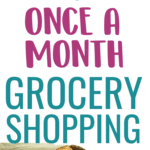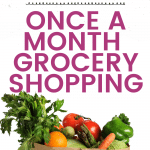How To Grocery Shop Once A Month (And Save Money)!
I’ve tried once a month grocery shopping before and failed. I wanted to like it. I really did.
I found myself running back and forth too many times picking up the things I ran out of and had forgotten. I ended up spending way too much money – more than my original budget.
Because I thought it was time to reign in my grocery budget and save some time, I knew it was a good time to try again. I decided to give it another shot. But this time I had a plan.
What is Once a Month Grocery Shopping?
Once a month grocery shopping doesn’t have to be as complicated as it sounds. It’s just planning out (in detail or rough guestimate) what you need to purchase for an entire month. It doesn’t mean you can’t run out to get milk or bananas if you need them, but it does mean that the majority of your shopping is only done one time.
Not only is it a money saver, but it is also a time saver once you get organized. To make it easier, I have some tools for you that you will see below.

Why would you want to shop only once a month?
Are you are finding that trying to grocery shop every other week with your job and family is getting a little stressful? Life gets busy. With work, family, social obligations, and a home, time seems to disappear.
Finding two hours to grocery shop every week can feel like a real challenge. How awesome would it be to shop for two hours a month instead of 8?
And then add that many need to shop on the evenings or weekends when it’s the busiest – that’s harsh. Sometimes it’s just easier to order take out.
I’m finding that this winter, for example, we would have a snow day or something would come up, and I was just not able to get there. Then I would end up out on a Saturday. I do not find that ideal. Here is a list of reasons to try once a month grocery shopping.
Save time. One day a month. All-day. And that’s it. You will not have to shop again for the entire month. Whether you’re working in the home or out of the house, limiting the trips to the grocery store is a blessing.
buy in bulk. Head to two or three stores and buy in bulk. Grab those bigger bags of flour. And don’t worry about running out if you need or want to start baking your bread.
Better prepared for illness, emergencies, or laziness. Or surprise school closings, in my case. Even though we are all home right now and summer is coming, I love the idea of having a lot of food in the house.
You never know when an emergency will come up, and you can’t leave your home. Or your kids catch the stomach bug, and you can’t get to the store.
It gives me a sense of control, and I find comfort in the knowledge that I can feed my family. Including my grown children and granddaughter if needed.
Saving money. This might be my favorite part of grocery shopping once a month. I was able to get the whole month’s groceries for $286.02. Usually, I am spending about $400 a month. I think I can do better next month.
I thought, as stated above, I would spend about that. I did get milk at Target when I was there picking up some other things. And I am prepared to grab some produce at my local grocery store if needed.
But there are some challenges.
What are the challenges with this type of grocery shopping?
Time-consuming
It’s an all-day adventure for me. I hit several stores, including Aldi, BJ’s, Target, and maybe even Hannaford, if I can’t find what I want from other stores. But it’s just once.
Running out of something
Yup. What if you run out of milk, bread, eggs, or bananas? You could send your sweet husband to the store on his way home from work, or you could just make do.
I guess it would depend. If you are a big milk drinker and will need it for cereal, dinner, and cooking, then you might want to grab another gallon. If it’s bananas, then could you substitute another fruit?
Some people will go out for a quick weekly grocery shopping trip to stock up on milk and produce.
And how long do you have before the month runs out and you shop again? You might be able to stretch it if it’s only three or four days. Nine days might be a different story.
Forgetting something
What happens if you forget the sour cream? You are going to need that for seven different meals, right? Again, if you can’t live without it, go to the corner convenience store or town grocer and grab it when you need it. Things happen.
Milk and dairy
We eat frozen cheese daily. Milk and yogurt both freeze well; however, some dairy will change texture and consistency, but if your family is ok with that, then go for it.
They might not even realize. I have found many dairy products that will last a month in the refrigerator.
Produce
This might be the most challenging obstacle. Buy all the produce. Decide which items go bad the fastest and eat those first. Strawberries, grapes, cucumbers, some lettuces will start to get soft relatively quickly.
Items like apples, pears, potatoes, and carrots will last. Consider canned and frozen for the end of the month.
Sales
Many people like to shop the sales. And I know some who will do the big grocery haul and still set a few dollars aside to shop weekly sales and use coupons.
It’s just not worth it to me personally. I would instead use my time doing other things than chase sales every week. Plus, it takes me 20-30minutes to get to most stores from where I live.
Kids will eat everything in one week
Consider hiding snacks. Or merely explaining to them that they need to make these snacks last. I don’t even have to tell mine that if they eat them all in the first week, they will have nothing left. They now know.
Or simply say no.
When you do this type of shopping, where do you store all the things?

Where do I put it?
We have a nice stand-up freezer in the basement with plenty of room for all the food. But we have no pantry. So we put up shelves in the basement where we keep a lot of the canned and bottled items.
The boxes of stuff (because our basement can be a little damp), we store on shelves above the washer and dryer. I have heard of people storing food under beds and cleaning out coat closets or linen closets to make room. You may need to get creative.
So how do you figure out how much to buy?
How much food do we need?
Depending on the size of your family, I would say a lot. Maybe not as much as you think and probably more than you think. You will find as you do this, you will need to make adjustments.
I know that next time, I will need to buy more fruit, yogurt, and slices of cheese.
Track Your Food. Keep track of what you eat and how much. Or sit down and recall what your family eats on a regular basis. If you buy a gallon of milk each week, you will need four gallons. One box of cereal equals four boxes of cereal.
Keep in mind that there will be calculation errors and you will have to tweak the plan as you go along.
Build up a stockpile. If you have the money, buy some extra pantry items to build up an inventory. This will give you an excellent foundation to plan from your own little store. It’s a technique that I love called reverse meal planning, and it pairs nicely with once-a-month grocery shopping.
Maximize freezer space. Do the best you can here. If you can afford it and have space, consider purchasing a small freezer. They have good deals all the time on them.
Try buying used on the Facebook marketplace or craigslist. My daughter-in-law and oldest son found a small chest freezer (brand new) at Home Depot for under $100 a few years ago. I am seeing small chest freezers at around $250 today.
I have my favorite stores, and I have done the research in my area for my grocery ebook.
Where do we shop for all those groceries?
My favorite store is Aldi (if you don’t already know). That’s where I do the majority of my monthly grocery shopping. If you’re lucky enough to have a decent one near you, then I would suggest it. I have a great article about Aldi.
Their prices can’t be beaten. Trust me. I’ve done the research. The second option is the more available one, Walmart is a close second for the best prices.
I then go to BJ’s Warehouse. I have a running list of the things I like to buy there, including peanut butter, oil, breakfast sausage, cheeses, and some meats. Their packaging is MADE FOR once a month shopping. And their deli is fantastic! Here is an article about those warehouse stores.
Even though it has nothing to do with groceries, I also try to keep my Target visits once a month. I always go at the beginning of the month after taking inventory of household items I may need.
Sometimes I can find items I need to fill in some food holes from their grocery section (which is small in my store). My son likes Annie’s canned pasta. Aldi does not carry them, but Target does.
And last, if I need to, I will swing into Hannaford. It’s 58% more expensive than Aldi, so I try to stay out.
Now that you know everything about stretching out the time between grocery store visits, here are my favorite tips.
19 Tips to Grocery Shopping Once a Month on a Budget:
1. Save Up Some Cash.
Skip a grocery trip or two (or four) and do a pantry challenge to save up some money to do the great grocery haul. The income tax return is also upon us, so if you could use some of that money to get a jump on it, that might be an option.
2. Shop alone.
Stay hydrated and get it all done. I understand this might be impossible for some, but if you can swing it, you’ll be able to concentrate on what you are doing to make the best choices.
3. Fresh produce.
Consider how you will deal with fresh produce. It’s a challenge. Will you buy all the produce and eat what goes bad first, then save the rest for later in the month, or will you swing by the store to pick up some halfway through?
4. Keep a running list.
As you plan, keep a list of what you run out of. This should be a permanent fixture in your kitchen. Feel free to download my FREE Master Grocery List so you can circle what you need.
5. The Rules.
Decide beforehand what your “rules” are. Do you go to the store if you run out of essentials like milk or bananas, or do you make do? We do not have young kids in the house anymore, so if we run out, then everyone has to wait (or buy their own).
I buy 2 gallons of milk for the month. When it’s gone, it’s gone.
6. Plan meals.
Start planning meals first from what you already have. I have a post about Reverse Meal Planning that has some great information.
7. Don’t be afraid of SOME prepackaged foods.
Let’s face it. There will be those times when it’s just easier to make boxed mac and cheese, open a can of peas, and throw some fish sticks in the oven. Go with it. Not always. Just sometimes.
8. Practice flexibility.
Sometimes stores may not have what you want. They may not have boneless chicken, so you might have to sub with a whole chicken or ground turkey instead. Don’t be so structured when shopping that you lose the motivation to keep going.
9. Expiration dates.
Keep an eye on expiration dates when shopping. Most things like yogurt and milk will last as long as the date is current. Sometimes stores will sell items too close to that date. Just be aware. Also, with things like fresh spinach, the later dates will last longer on an item that doesn’t usually last.

10. Remember frozen veggies.
Picked at the peak of freshness and then flash frown, these are the veggies of choice for me.
11.Separate meat and freeze.
As soon as you get home, separate your meat if you buy in bulk and freeze. If your meal plan calls for browned ground beef four times, you could just brown it all and separate already cooked.
12. Clean out your space.
Clean out the refrigerator, pantry, and cupboards to take inventory and make room for all the new things. Give it a good cleaning and dispose of anything you feel has gone bad.
13. Start creating a month long meal plan.
As you’re having meals, jot down ideas from what you usually eat and ask the family what they like. Then write it all out, so everyone knows what’s going to happen for the next 30 days.
14. Keep staples on hand for “other” meals.
Consider those quick meal options like grilled cheese and tomato soup or frozen pizza for nights when life has been interrupted, or you are just too tired.
15. Learn to love leftovers.
Plan with leftovers in mind. For example, we had chili for dinner on Monday night. On Wednesday, we plan on having hot dogs with chili and cheese.
I made a bunch of baked chicken breasts to cut up for a casserole and chicken salad for lunches. We always plan for 2-3 (or more) leftover nights. I am adamant about not wasting food. Like it or not. Leftovers happen.
16. Date nights and family outings.
Always take a peek at your calendar to consider any special occasions that are planned. Birthdays, date nights, sports and school activities, and holidays typically have food-related considerations.
17. Make a detailed list.
Here it is. The core to the once a month grocery shopping plan. The detailed grocery list. Be sure to download my master grocery list free for your convenience. If you forget the list, go home and try again tomorrow. Do not try to wing it.
18. Make it a 35-day plan.
Add an extra few days as a cushion. Instead of 30 0r 31 days, consider 35 days. If you usually shop on the first Friday of the month, this will give you some flexibility.
19. Write the dates on snacks.
If you buy four boxes of snacks, write the date that this snack can be opened. For example, if you grocery shop on April 1, one snack can be open then. Write April 7 on the next, April 14, on the next and April 21 on the last. That way, each snack has an assigned week, and all the snacks aren’t inhaled the first week.

Once a month, shopping is NOT for you if:
You’re someone who lives tiny without storage.
If you live in a very small space or a tiny house without an ounce of storage anywhere, you will not be able to buy all the food and supplies for a month. If you do not have a freezer, it’s just not going to work for you. You might be able to work it out if you have a decent freezer as part of your refrigerator. Strategically repackaging foods might be your best bet.
You are not a planner.
You instead fly by the seat of your pants and spontaneously decide what you’re in the mood to eat every night. Yep. This is not for you.
You have no discipline.
If you will eat all the snacks for the month in the first week, this is not for you. If you are not able to stay away from the grocery store when you want Swedish fish and ice cream on a whim, you might want to try something else.
You get overwhelmed at big jobs.
It’s a big job with oodles of reward. So if you get stressed and overwhelmed over hard things, maybe pass on once a month grocery shopping.
Final thoughts on once a month grocery shopping:
It takes some time to plan and an entire day to facilitate, but it’s worth it. Especially if it takes you at least 20 minutes to get to a store. I have enjoyed this style of shopping. It has saved me time, money, and stress.
After diligently working on this plan for the last three months, I can honestly say that I really like grocery shopping only once a month. In the long run, I think it will be great for our family, both financially and mentally.
Do you grocery shop once a month? Let me know in the comments below.




